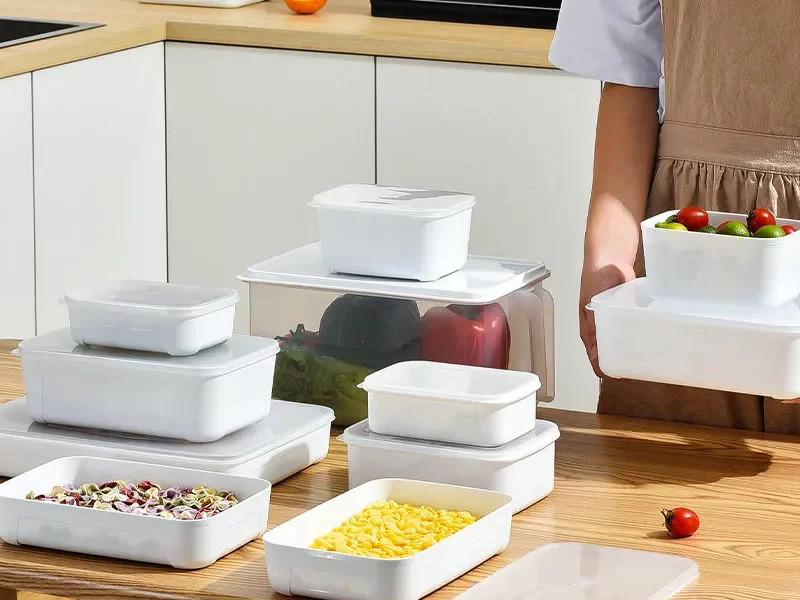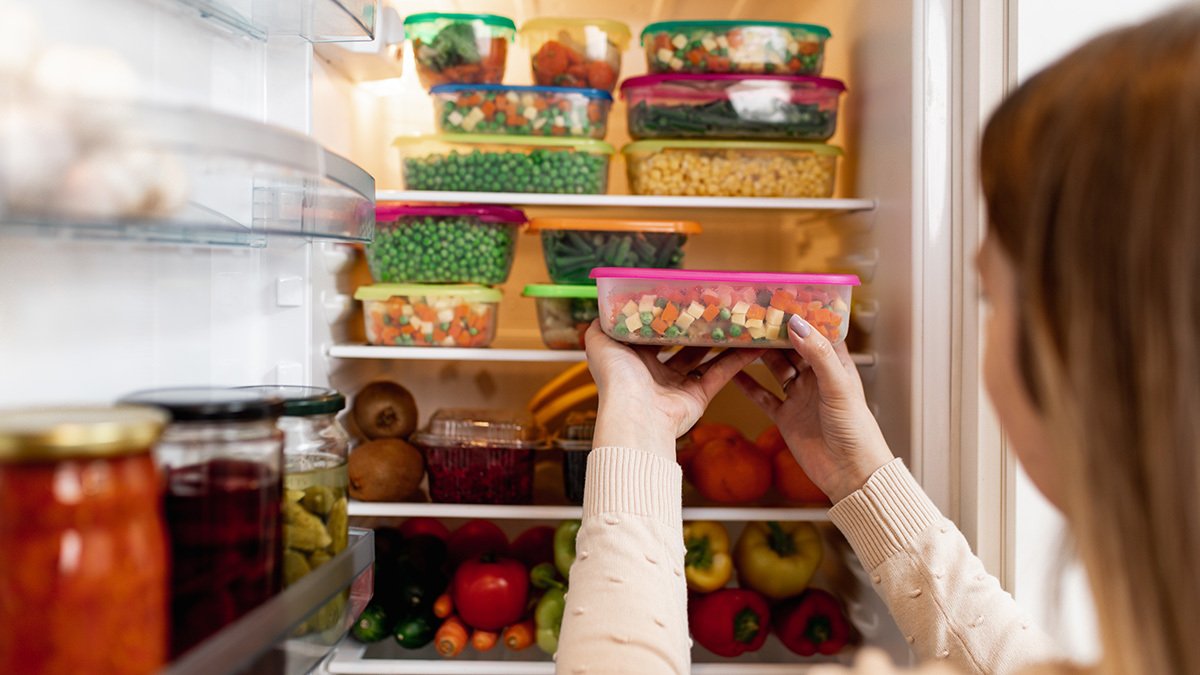
플라스틱은 전 세계에서 가장 널리 사용되는 식품 보관 재료입니다. 플라스틱 보관 용기는 가볍고 저렴하며 가정이나 식당에서 음식을 보관하는 데 적합합니다. 플라스틱 용기의 많은 장점에도 불구하고 일부 기업과 가정에서는 잘못된 정보로 인해 여전히 플라스틱 용기를 사용하지 않는 경우가 있습니다. 예를 들어, 플라스틱 용기는 BPA와 같은 유해한 화학물질이 포함되어 있어 식품 보관에 적합하지 않다고 생각하는 사람들이 많습니다. 하지만 이는 사실이 아닙니다.
실제로 플라스틱 용기의 식품 등급 표시로 구분할 수 있는 BPA와 같은 물질은 플라스틱의 극히 일부분만 포함될 수 있습니다. 이 기사에서는 플라스틱 식품 등급의 의미와 식품 보관에 가장 안전한 플라스틱 용기에 대해 자세히 설명하여 플라스틱 식품 보관의 안전성을 이해할 수 있도록 합니다.

플라스틱에서 식품 등급은 무엇을 의미합니까?
식품용 플라스틱은 기본적으로 식품 보관용이나 식기와 같이 식품용으로 안전한 것으로 간주되는 플라스틱 소재입니다. 특정 순도 기준을 충족하도록 제조되며, 이는 제조 과정에서 인체 건강에 위험을 초래할 수 있는 물질이 사용되지 않음을 의미합니다. 식품 등급으로 간주되려면 플라스틱 용기는 첨가물, 염료 및 기타 유해한 제품이 없어야 하는 등 특정 규정을 충족해야 합니다.

플라스틱 용기는 바닥에 1~7등급의 식품 등급이 표시되어 있습니다. 이를 통해 소비자는 플라스틱이 식품 보관에 얼마나 안전한지 알 수 있습니다. 식품용 플라스틱은 규정을 준수해야 합니다. 염료, 첨가제 또는 유해한 제품을 포함할 수 없습니다. 식품용 플라스틱에는 재활용 소재가 포함될 수 있지만 적절한 가이드라인을 충족해야 합니다. 식품의약품안전처는 식품과 접촉했을 때 재료가 어떻게 작용하는지를 결정할 책임이 있습니다.
1~7등급 플라스틱 소개
1: PET 또는 PETE - 폴리에틸렌 테레프탈레이트인 이 플라스틱은 재활용 삼각형의 1번으로 표시되어 있습니다. PET 플라스틱은 투명하고 견고하며 가스와 습기에 강합니다. 이 플라스틱은 청량음료, 주스, 생수 등의 음료에 주로 사용됩니다. 땅콩버터, 피클, 샐러드 드레싱과 같은 식품에도 사용됩니다.
2번: 고밀도 폴리에틸렌 - 우유병, 일부 주스 용기 및 세탁 제품에 일반적으로 사용되는 플라스틱입니다. 삼각형 코드에 2번으로 표시됩니다. 이 용기는 반투명 또는 유색일 수 있으며 다소 단단하여 우유와 같이 유통기한이 짧은 제품을 포장하는 데 이상적입니다.
숫자 3: PVC - PVC(폴리염화비닐)라는 용어가 사용되면 대부분의 사람들은 플라스틱 파이프를 떠올립니다. 삼각형 코드에 숫자 3이 표시되어 있습니다. 이 플라스틱은 내후성이 뛰어나며 집 주변의 전기 케이블에 사용되며 창틀, 바닥 타일 및 주택의 사이딩의 주요 재료입니다. 이 플라스틱은 식품 및 비식품 용도로 모두 사용할 수 있습니다. 식품을 용기에 보관하기 전에 해당 용기가 산업 또는 건설용으로 처리되지 않았는지 확인하세요.
4번: LDPE - 저밀도 폴리에틸렌 플라스틱은 삼각형 코드에서 숫자 4로 표시됩니다. 드라이클리닝 봉투, 빵 및 냉동 식품 봉투, 겨자나 꿀을 짜서 담는 짜먹는 병 등 다양한 품목에 사용됩니다. 식품 보관용으로 재활용하려면 이전에 어떤 용기에 담겨 있었는지, 얼마나 쉽게 살균할 수 있는지 고려하세요. 장기 식품 보관에 가장 적합한 플라스틱은 아닐 수 있습니다.
5번: PP - 폴리프로필렌은 삼각형 코드에서 숫자 5로 표시되어 있습니다. 이 플라스틱은 질기고 딱딱하거나 유연할 수 있습니다. 요구르트 용기, 마가린 통, 약병 등이 이 플라스틱으로 만든 식품용 용기의 예입니다. 폴리프로필렌은 얼음 국자, 기름 깔때기, 갈퀴, 쟁반, 냉장고 식품 보관함 등을 만드는 데도 사용됩니다. 널리 사용되는 플라스틱입니다.
숫자 6: PS - 재활용 삼각형에서 숫자 6으로 표시된 폴리스티렌입니다. 투명하고 단단하며 잘 부서지는 단단한 플라스틱 또는 발포체입니다. 일반적으로 컵, 접시, 수저, 달걀 상자, 고기 트레이, 컴팩트 디스크 슬리브 등에 사용됩니다. 포장에 널리 사용되지만 일반적으로 식품 보관에 적합한 용기에는 사용되지 않습니다.
7번: 마지막 카테고리는 7번입니다. 이 코드는 포장재가 위에 나열된 6가지 수지가 아닌 다른 수지로 만들어졌거나 이 중 두 가지 이상의 수지를 조합하여 만들어졌음을 나타냅니다. 식품 및 식품 보관의 경우, 7번 용기는 일반적으로 3갤런 및 5갤런 재사용 가능한 물병/주전자, 일부 감귤 주스 용기, 케첩 병에 사용됩니다.
어떤 플라스틱 번호가 식품 보관에 적합할까요?
| 플라스틱 번호 | 플라스틱 | 식품에 안전한가요? | 사용 방법 |
| 1 | PET | 예 | 일회용 병 |
| 2 | HDPE | 예 | 주스 및 우유 주전자 |
| 3 | PVC | 아니요 | 파이프, 호스 및 패킹 |
| 4 | LDPE | 예 | 빵 및 농산물 봉투 |
| 5 | PP | 예 | 약병, 식품 보관함 |
| 6 | PS | 아니요 | 플라스틱 식기, 커피 컵 |
| 7 | 기타 플라스틱 | 예 | 젖병, 물병 |
이제 각 플라스틱과 용도를 세분화하여 안전한 플라스틱 번호표에 따라 2, 4, 5등급의 플라스틱은 식품 보관에 사용할 수 있으며, 여기에는 HDPE, LDPE, PP 소재가 포함되며 이러한 용기는 독성 화학물질이 용출되지 않고 식품을 보관할 수 있습니다. 5번인 PP 소재는 식품 보관에 가장 적합한 소재입니다. 1등급 플라스틱은 직사광선에 노출되지 않고 한 번만 사용하는 경우에만 안전합니다. 3등급 또는 6등급 플라스틱은 사용하지 마세요.
결론
플라스틱의 독소에 대한 인식이 높아지면서 식품을 안전하게 보관하는 방법을 아는 것이 중요해졌습니다. 올바른 식품 보관 용기를 사용하면 해로운 박테리아와 독소가 인체에 유입되는 것을 방지할 수 있습니다. 이는 심각한 건강 문제를 예방하고 재생 가능한 재료를 사용하여 지구를 더 친환경적으로 만들 수 있습니다.
일반적인 오해와 달리 플라스틱은 식품 보관에 있어 일반적으로 안전합니다. 식품 보관에 적합한 플라스틱 식품 용기 소재를 선택하면 식품을 안전하게 보관할 수 있습니다.


가장 안전하고 품질이 우수한 플라스틱 용기를 찾고 계신다면, LEBO 는 여러분이 찾고 있는 플라스틱 용기 공급업체입니다! 다양한 품질과 합리적인 가격의 도매 식품 보관 용기건조 식품 보관 용기부터 냉장고 식품 보관 용기까지 다양한 식품을 보관할 수 있습니다. 당사의 가장 인기 있는 도매 플라스틱 식품 용기는 특별히 PP 소재로 제작되었습니다.를 사용하여 품질과 안전성을 보장합니다.
전체 제품군을 확인하시고 제품에 대해 자세히 알아보려면 언제든지 문의해 주세요.
